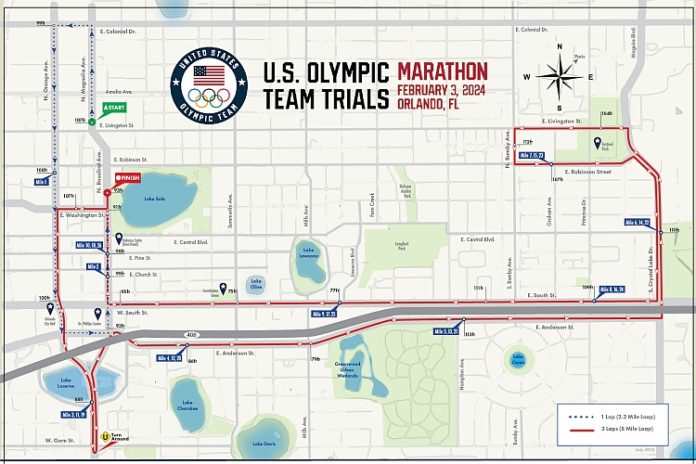★ The Sports Examiner: Chronicling the key competitive, economic and political forces shaping elite sport and the Olympic Movement.★
★ To get The Sports Examiner by e-mail: sign up here! ★
≡ THE 5-RING CIRCUS ≡
1. England and Denmark sail into World Cup playoffs
2. U.S. swimmers did better at Nationals than World Champs
3. Fairly flat U.S. Olympic Marathon Trials course in Orlando
4. USA-Dutch World Cup tie dominates weekly TV ratings
5. Anger over UK Athletics selecting just 51 for Budapest
England was one of the favorites coming into the FIFA Women’s World Cup and looked like it on Tuesday, crushing China by 6-1 and winning Group D. Denmark beat Haiti, 2-0, and also moves on to the elimination round. A TSX analysis shows that only a third of U.S. swimming entries posted better times at the World Aquatics Championships than at the USA Swimming nationals at which the team was picked! And the problem was especially acute for the women: just seven entries out of 34 did better in Fukuoka than in Indianapolis. The course for the U.S. Olympic Marathon Trials next February in Orlando, Florida was posted: it’s pretty flat, but the races will be run beginning just after noon. Too late and too hot? The Women’s World Cup tie between the U.S. women and the Netherlands dominated the sports television audience ratings last week, but most of the other games did modestly due to the adverse time zones for American viewers. The British track & field federation named a pretty small squad for the World Athletics Championships, skipping anyone who did not make the very tough direct-qualification standards or who is not an obvious medal contender. Legal action is being considered and the policy has been loudly criticized. This is not the approach in the U.S.
● Panorama: Archery (reasonable financial report for World Archery) ●
1.
England and Denmark sail into World Cup playoffs
As the group stage of the FIFA Women’s World Cup in Australia and New Zealand heads toward the close, highly-regarded England unloaded on China and Denmark also moved on from Group D on Tuesday. No surprise there, except that the English had only scored one goal each in wins over Haiti and Denmark.
● Group D: England 6, China 1 ● The Lionesses completely dominated China to finish group play with a 3-0 record, holding 74% of possession (!) and piling up 17 shots to seven in a 6-1 rout in Adelaide (AUS).
England took control right away, as a header from star midfielder Lauren James got to the feet of striker Alessia Russo in the fourth minute and she finished with a right-footed rocket that ran into the left side of the Chinese goal for the 1-0 lead. In the 26th, James’s pass set striker Lauren Hemp up ahead of the defense and she left-footed a hard shot into the left side of the net for a 2-0 lead.
James finally got to score herself in the 41st, receiving a free kick with plenty of space the box and whistling a right-footer into the net: 3-0, and the rout was on. James scored again at 45+5, but the goal was waved off for offsides after a video review.
China got a break in the 57th, as England was called for a hand-ball and striker Shuang Wang scored the first goal against England in this tournament. But James was back on the ball in the 65th, volleying in a perfect cross to the far side of the goal from Jess Carter from the right side for a 4-1 edge. Two goals, two assists and a goal lost to a video review for James!
Substitute striker Chloe Kelly scored in the 77th after Chinese keeper Zhu Yu overran the ball and left an open net, and midfielder Rachel Daly got the final goal in the 84th after a failed clearance gave her the opening for a right-footed finale.
England will now face Nigeria in the round-of-16 in Brisbane on the 7th.
● Group D: Denmark 2, Haiti 0 ● Although Denmark controlled the game, it had only a single goal to show against winless Haiti until the very end, but managed a 2-0 win in Perth.
Haiti was called for a hand-ball in the 21st minute and midfielder Pernille Harder slammed home the penalty in the 21st for a 1-0 lead that held up through halftime and into the second half.
Haitian keeper Kerly Theus made a sensational, one-on-one save against substitute midfielder Mille Gejl at 90+2, coming out to block the shot and sent it out of bounds.
But substitute midfielder Sanne Troelsgaard got a lead pass from Gejl and was clear to score on a diagonal shot from right to left to the far post at 90+10 for the 2-0 final.
The Danes had 62% of possession and while both sides recorded nine shots, Denmark had six on target to only two for Haiti, which leaves 0-3. Next up for Denmark: a date with host Australia in Sydney on the 7th.
The final group standings have England at 3-0 (9 points), joining Japan with a perfect record, followed by 2-1 Denmark (6), then China (1-2: 3) and Haiti (0-3: 0).
Looking ahead to the round-of-16, Europe now has six spots clinched and is in position to secure four more, possibly giving them 10 of the 16, even better than the 8/16 from 2019, which produced seven of the eight quarterfinalists.
2.
U.S. swimmers did better at Nationals than World Champs
One of the eternal problems in sports for a country as powerful as the United States is how to pick its entries for international competitions. In swimming, like track & field, the answer has been to take the top finishers at the national championships.
But, in doing so, there is often more pressure to make the team than to win medals at the Olympic Games or World Championships. This was once again demonstrated at the just-concluded World Aquatics Championships in Fukuoka (JPN).
A review of performances at the USA Swimming National Championships in Indianapolis from 27 June to 1 July showed that only 22 performances out of 66 (33.3%) were better at the Fukuoka Worlds than at the trials.
The U.S. men won 14 World Championship medals in individual events (2-8-4) and out of 32 qualifying swims at the Nationals, the same athletes produced 15 marks in their final round of competition in Fukuoka that were better (44.1%):
● 6-12 in Freestyle
● 3-6 in Backstroke
● 1-5 in Breaststroke
● 3-5 in Butterfly
● 2-4 in Medley
Historically, this is not bad at all, although the American team produced golds only in the 50 m Back (Hunter Armstrong) and 100 m Back (Ryan Murphy).
The women’s situation was a lot different. The U.S. women won more medals – 16 (3-8-5) – than the men (same number of events), but produced only seven swims in Japan than were faster than Indianapolis, out of 34 entries: just 20.1 percent:
● 4-12 in Freestyle
● 1-6 in Backstroke
● 0-6 in Breaststroke
● 0-6 in Butterfly
● 2-4 in Medley
The medal count was impressive, but even where the U.S. went 1-2 in the 400 m Medley with Kate Douglass and Alex Walsh, they swam slower than at the Nationals. The American women got wins from Douglass and two from Katie Ledecky.
(The U.S. also won medals in all eight relays, which are not counted in the trials-Worlds statistics.)
This year’s national championships ended on 1 July and the swimming at the Worlds began on 23 July, just a day more than three weeks later. Too close? Too long a trip to Japan?
USA Swimming National Team Managing Director Lindsay Mintenko and the eventual U.S. coaching staffs will have to ponder the preparation routine for 2024, and will have a little more time. The U.S. Olympic Swimming Trials extravaganza at the Lucas Oil Stadium in Indianapolis next year will be held from 15-23 June, with perhaps the biggest crowds in swimming history.
The swimming events in Paris for the Games don’t start until 27 July, in the much more cozy Paris La Defense Arena, expected to seat 15,220. That’s a 34-day spread instead of 21, and a friendlier trip from the U.S. to western Europe than to Asia.
After the experience of Fukuoka, with less than half of the men and only 20% of the women producing better marks there than what it took the make the team, it’s a problem that is going to have to get solved.
3.
Fairly flat U.S. Olympic Marathon Trials course in Orlando
The actual course for the 3 February 2024 U.S. Olympic Marathon Trials in Orlando, Florida was posted on Tuesday, with a loop course and a noon start.
The men will start at 12:10 p.m. and the women at 12:20 p.m., running a 2.2 mile loop in the downtown business district before transitioning to three loops of an eight-mile course, finishing at the Walt Disney Amphitheater beside Lake Eola.
This is a fairly flat course, with the start at 107 feet, with the end of the short loop at 91 feet and the three eight-mile loops with a maximum rise from 79 to 113 feet and a corresponding downhill on the return. The finish line is at 93 feet.
Given Orlando’s reputation for warm and humid weather, the noon start has raised eyebrows, and the 10-year data on the weather at the Orlando International Airport shows that’s occasionally cool, but usually fairly warm in mid-day on 3 February:
● 2023: 78 F at noon ~ 69 F at 2 p.m.
● 2022: 78 F at noon ~ 82 F at 2 p.m.
● 2021: 48 F at noon ~ 53 F at 2 p.m.
● 2020: 68 F at noon ~ 70 F at 2 p.m.
● 2019: 65 F at noon ~ 69 F at 2 p.m.
● 2018: 66 F at noon ~ 68 F at 2 p.m.
● 2017: 75 F at noon ~ 77 F at 2 p.m.
● 2016: 79 F at noon ~ 81 F at 2 p.m.
● 2015: 59 F at noon ~ 64 F at 2 p.m.
● 2014: 79 F at noon ~ 81 F at 2 p.m.
Humidity, however, is high in February in the mornings, but – on average – drops to 69% by 10 a.m., 53% by noon and 50% by 4 p.m. So the race could be run in drier conditions with a noon start.
NBC will televise the event live in its entirety. As of 13 July, USA Track & Field lists 150 qualified men (144 from marathons, six from half-marathons) and 130 qualified women (117/13).
4.
USA-Dutch World Cup tie dominates weekly TV ratings
A very quiet week for international sport on television, with the FIFA Women’s World Cup dominating the scene. The U.S. vs. Netherlands match, on at a reasonable hour in the U.S., drew 6.430 million on Fox and another 1.371 million for Spanish-language coverage on Telemundo and Universo.
The next closest was 888,000 for Argentina and South Africa on FS1 on Thursday:
Monday, 24 June:
● 661,000: Colombia vs. South Korea on FS1 (9:45 p.m. Eastern time)
● 176,000: Colombia vs. South Korea on Universo (9:30 p.m.)
● 242,000: New Zealand vs. Philippines on FS1 (1:00 a.m.)
● 235,000: Brazil vs. Panama on FS1 (6:45 a.m.)
Tuesday, 25 July:
● 201,000: Japan vs. Costa Rica on FS1 (12:40 a.m.)
Wednesday, 26 July:
● 6.430 million: USA vs. Netherlands on Fox (8:45 p.m.)
● 1.165 million: USA vs. Netherlands on Telemundo (8:30 p.m.)
● 206,000: USA vs. Netherlands on Universo (8:30 p.m.)
● 336,000: Canada vs. Ireland on FS1 (7:40 a.m.)
Thursday, 27 July:
● 888,000: Argentina vs. South Africa on FS1 (7:40 p.m.)
● 289,000: Australia vs. Nigeria on FS1 (6:00 a.m.)
● 180,000: England vs, Denmark on FS1 (4:10 a.m.)
Friday, 28 July:
● 308,000: England vs. Denmark on FS1 (6:00 a.m.)
● 264,000: China vs. Haiti on FS1 (6:40 a.m.)
● 208,000: France vs. Brazil on Fox (5:40 a.m.)
Saturday, 29 July:
● 781,000: Panama vs. Jamaica on Fox (8:00 a.m.)
● 597,000: South Korea vs. Morocco on Fox (12:10 a.m.)
● 589,000: France vs. Brazil on Fox (6:00 a.m.)
● 399,000: Switzerland vs. New Zealand on Fox (2:40 a.m.)
● 183,000: Germany vs. Colombia on FS1 (5:15 a.m.)
Sunday, 30 July:
● 384,000: Germany vs. Colombia on FS1 (6:00 a.m.)
One other program of note, with NBC’s highlights of the World Aquatics Championships in Japan drawing 697,000 on Sunday (30th).
Both the Women’s World Cup and NBC’s streaming coverage of the Worlds swimming were hurt by the difficult time zones in Australia, New Zealand and Japan for U.S. viewers.
5.
Anger over UK Athletics selecting just 51 for Budapest
UK Athletics, the national governing body for track & field in Great Britain, named a 51-member team for the 2023 World Athletics Championships in Budapest this month and has been roundly criticized for leaving qualified athletes at home.
The federation’s policy – spelled out in advance – was to name athletes who had met the very tough World Athletics qualifying standard in each event, assuring they would be competitive at the highest level.
Last Friday’s team announcement included only 51 athletes, compared to 78 for the 2022 Worlds in Eugene. It’s reportedly the smallest British team at the Worlds since 2005.
Said UKA Technical Director Stephen Maguire: “The policy is set out a year in advance. Our selection is very much based on the philosophy of challenging for finals and ultimately winning medals.
“This is about top end of performance. This isn’t about cost. If we had 80 people making the team at the level we have set then hallelujah, that’s great.
“I’m really hoping that the athletes give us real headaches next year and many more people are hitting standards.
“When people don’t make standards, there’s probably a bit of emotion. Athletes will be hurt because they haven’t made standards and the world and Olympic standards are tough.
“But I don’t think the standards are too difficult. It has highlighted some of the work that we have to do. My advice would be to grasp the nettle, train hard and put yourself in a good position.”
There has been talk of legal action against the federation; the issue was superbly presented by longtime British observer and statistician Peter Matthews, writing in Athletics International:
“[The UKA selection process] ignores the fact that World Athletics now have a two-tier system so that there is a very high qualifying standard and then athletes are invited from the World Rankings to fit a specified quota. It has been reported that a further 20 British athletes would be invited by WA from the rankings, yet UKA refuses to accept them. Athletes such as Lina Nielsen, Josh Zeller, Jade Lally and Amelia Strickler were quoted in the media as being extremely cross.
“Surely most other nations would not take this attitude. To my mind this is an utter disgrace and does a gross disservice to the sport, preventing athletes from the honour of representing their country (and very different from the days of inter-nation matches, the European Team Champs is the only senor international event at which an athlete must be chosen for every event), preventing them from gaining invaluable experience and surely a de-motivating factor for athletes in many events.
“It is also a snub to British athletics supporters, who have no superiors around the world. I suppose a factor in this appalling behaviour by UK Athletics is probably that the funding they get depends on medals gained at global championships. This is not the first time they have denied participation to qualified athletes, but together with the neglect of the domestic athletics programme in the UK that means many aspiring British athletes have to travel regularly to the European continent to get appropriate competition, is another sign of their dreadful governance. Athletes so affected by this latest treatment may try to appeal, but time is short. What is needed is a totally different approach and use of resources by our governing body.
“While there are full squads for the five relays, there are only 12 men and 23 women for individual events. Britain will have no competitor in 11 of the 24 men’s events – with just one field eventer, and no distance runners!, and in 7 of the 24 women’s events.”
Observed: This is not the USA Track & Field policy, or the policy of the U.S. Olympic & Paralympic Committee, who generally want to take every American athlete who is qualified to the Olympic Games or World Championships, as appropriate. This is not a small thing, and is one of the areas which the Commission on the State of the U.S. Olympics and Paralympics is obligated to review, with their first hearing expected on 6 September.
≡ PANORAMA ≡
● Archery ● The World Archery Congress preceded the now-underway World Archery Championships in Berlin (GER), reporting reasonable financial stability, underpinned by the IOC’s Olympic television dividend.
The 2022 financials showed that World Archery is at CHF 10.00 million in assets with CHF 7.74 million in cash and investments. Revenue was CHF 7.02 million and expenses were CHF 5.28 million, a positive due to the Olympic television money (CHF 4.13 million), which the federation spreads out over the four-year cycle (CHF 1 = $1.14 U.S.).
¶
You can receive our exclusive TSX Report by e-mail by clicking here. You can also refer a friend by clicking here, and can donate here to keep this site going.
For our updated, 787-event International Sports Calendar (no. 3) for 2023 and beyond, by date and by sport, click here!

























